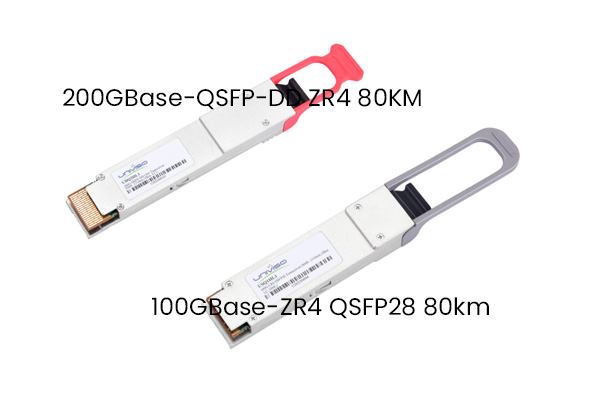 200GBase-QSFP-DD ZR4 80KM VS 100GBase-ZR4 QSFP28 80km
200GBase-QSFP-DD ZR4 80KM VS 100GBase-ZR4 QSFP28 80km
First, it is necessary to clarify your own transmission rate and bandwidth requirements. If the current and foreseeable future business bandwidth needs can be met with 100Gbps, then the QSFP28 100G 80KM transceiver is fully capable. For example, the daily office networks of some enterprises, which mainly handle regular business such as file transfers, email sending and receiving, and video conferences, 100G bandwidth is sufficient to ensure smooth operation. But if the business involves high-speed transmission of large-scale data, such as massive data interaction between data centers, real-time transmission of high-definition videos, and data synchronization in large-scale online games—scenarios with extremely high bandwidth requirements—the 200G 80KM transceiver can provide more abundant bandwidth, avoiding problems such as transmission freezes and delays caused by insufficient bandwidth.
Cost is an important factor that cannot be ignored when choosing a transceiver. Generally speaking, the cost of the QSFP28 100G 80KM transceiver is relatively low. This is because its technology is highly mature, and the market competition is sufficient. Costs in all links, from chip manufacturing to module assembly, have been effectively controlled. Both the equipment procurement cost and the later maintenance cost are within the acceptable range of most users. The QSFP28 200G 80KM transceiver, on the other hand, adopts more advanced technologies and higher-performance components, resulting in higher manufacturing costs and a correspondingly higher price than the 100G version. When deployed on a large scale, the cost difference will be more significant. Therefore, if the budget is limited and the bandwidth demand is not extremely urgent, the 100G transceiver may be a more economical choice. But from the perspective of long-term development and business growth, if the bandwidth demand grows rapidly and the later upgrade cost may exceed the initial cost of directly choosing the 200G transceiver, then a one-time investment in purchasing the 200G transceiver may be more cost-effective.
Network compatibility and scalability are also key decision-making factors. If the existing network equipment and infrastructure are mainly built based on 100G technology, and there are no plans to upgrade the network architecture on a large scale in the coming period, choosing the QSFP28 100G 80KM transceiver can better compatibility with the existing network, reducing the risk of failures caused by equipment incompatibility. At the same time, some devices may not directly support the 200G rate, and forced upgrades may require replacing a large number of network devices, which will undoubtedly increase costs and implementation difficulties. However, if your network is in the planning or upgrading stage and has clear future expansion needs, such as planning to gradually increase the network rate to 400G or even higher, then the QSFP28 200G 80KM transceiver has better scalability. It can serve as an intermediate stage in network upgrades, laying the foundation for future higher-rate network upgrades and reducing the network downtime and costs caused by later upgrades.
In terms of technical performance and stability, both transceivers perform well, but there are also some differences. The QSFP28 100G 80KM transceiver has mature technology and stable performance after long-term market verification. Within the 80KM transmission distance, it can maintain reliable signal transmission with a low bit error rate and is less affected by external interference. The QSFP28 200G 80KM transceiver, on the other hand, adopts more advanced modulation technologies and higher-performance signal processing algorithms, which can also ensure signal stability and accuracy under high-speed transmission. However, due to its more complex technology, it may be relatively more sensitive to environmental factors such as temperature and humidity. In some harsh environmental conditions, additional heat dissipation or protection measures may be required to ensure its stable operation. Therefore, if the application scenario has complex or harsh environmental conditions, the environmental adaptability and stability of the transceiver need to be fully considered.
Headquarter address :Room 1603, Coolpad Building B, North District of Science and Technology Park, Nanshan District, Shenzhen,China.518057